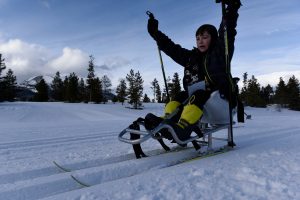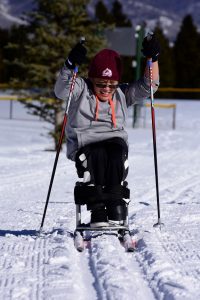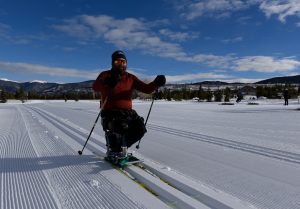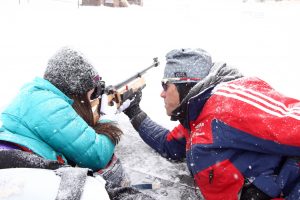Skip the Lift, Try Nordic Skiing
Nordic skiing, unlike its downhill equivalent, is accessible to far more athletes and areas of the country as it doesn’t require as much snowfall or mountains. All you need are Nordic skis and a trail map.
“Whether you are interested in a fun family activity, a sport you can enjoy for a lifetime, or the intense physical challenge that can come with competition, Nordic skiing is a great fit,” says Eileen Carey, U.S. Paralympics Nordic Skiing Head Coach. “Many of our athletes also love the fact that it is one of the only things they can do to get out in the woods independently and fully self-powered.”
Types of Nordic Skiing

For many athletes, Nordic skiing is a recreational sport that involves a more leisurely pace allowing the skier to enjoy the outdoors and chat with friends along the trail. For more competitive athletes, races are an all-body cardio workout and extremely challenging activity. Nordic skiing can also be used as a great cross-training activity for summer sports like running or cycling. No matter why you’re out on the trail, Nordic skiing takes on three main forms.
Classic Skiing
Classic skiing involves kicking and gliding in a forward-leaning motion. Classic Nordic ski tracks are deeply groomed, thinner tracks that run parallel to each other.
Skate Skiing
Skate skiing tracks are more widely groomed than classic tracks. The skate skiing motion moves the skis forward in a V pattern, similar to rollerblading or ice-skating.
Back-Country Skiing
For athletes with a bit more experience, back-country skiing is typically done in more remote locations like a state or national park instead of at a Nordic center. This type of Nordic skiing is done off of groomed trails and the individual skier, or the leader of the group, is actually breaking the trail instead of sticking to pre-cut trails as in classic and skate skiing.
Getting Prepared

Before you head out, call up your local Nordic center. Most will be able to provide rentals and beginner lessons for stand-up skiers. If you need sit ski equipment, Carey recommends reaching out to see if a local Disabled Sports USA Chapter or Paralympic Sports Club offers Nordic skiing or can provide rental equipment for the day.
Not sure what to wear? “Dress for being very active,” says Carey. “The biggest mistake first timers make is wearing the same clothing they might wear to downhill ski.”
She recommends dressing like you would to go out for a run in the cold weather. Dress in several non-cotton layers that you can remove as you warm up. Without the assistance of a ski lift or gravity in Nordic skiing, you will warm up quickly as your entire body is working to propel you through the snow.
Ready to Hit the Trail?
When you get to the Nordic center, the first thing you should expect is to meet your instructor, and get your skis. Discuss with them your mobility levels and any balance issues you might have as this will determine which ski type you use. At your first lesson, you can expect to learn some basic techniques including how to glide on the snow. The more you participate, the more naturally this “free speed” will come to you.
Stand-Up Skiers
Stand-up Nordic skiing independently requires the ability to walk and balance on one foot for a short period of time in order to glide through tracks. Athletes with arm amputations ski standing up without any prosthetic devices. They will learn how to adjust their forward motion using only one (or no) pole to propel them forward. Athletes with single leg amputations can ski standing up wearing their prosthetic leg.
Visually-Impaired Skiers
Visually-impaired skiers will use stand-up skis, poles and a guide. Guides often ski with a mic and speaker to give the athlete verbal commands. Guiding requires a large amount of trust between the guide and athlete to ensure they stay on course and at the proper speed throughout both the uphill and downhill sections of the course.
Sit Skiers
Athletes with spinal cord injuries, double leg amputations and some single leg amputees will use a sit ski, a piece of equipment with a seat mounted on top of two fixed skis. Sit skiing requires a lot of upper body strength, and Carey recommends that beginners get assistance pushing, especially on uphills. “It is a unique motion,” says Carey. “Sit skiers who like a challenge will be better off exploring more terrain and getting a little help when they need it, rather than staying in a small flat area.” The sit ski should fit snugly to the skier, and the design of the ski will vary depending on the level of injury. It is best to contact your local adaptive sports organization to find out what ski might best fit your body before heading out on your first lesson.
Staying Safe on the Trail

Remember that Nordic skiing involves the elements and that weather conditions can change quickly. Always pack enough warm clothing, even if you have to remove a couple of layers after you get going. Nordic skiers should always have at least one other person with them when starting out. If you’re planning on going out for a longer trek, make sure you take a trail map, water and a snack. Pack like you’re going out for a long hike.
Carey emphasizes focusing on your hydration, especially because cooler temperatures may not make it top of mind. “Remember that you may not be thirsty, but you still need to hydrate. This is especially important at altitude,” she cautions.
Racing
Not satisfied with casually trekking through trails, enjoying the serenity of nature? Consider racing. At the Paralympic level, Nordic ski races vary in distance from 1 kilometer sprints to the longer 20 kilometer endurance event for stand-up skiers and 1 kilometer sprints and 15 kilometer endurance distances for sit-skiers.
At the Paralympic level, races are split into Standing, Sitting and Visually-Impaired classes with skiers racing against others with similar ability levels. Standing skiers have the option of skiing classic-style or skate style, whereas sit-skis are designed to fit into the deeper classic-style tracks.
If you’re interested in racing, US Paralympics has a list of events that they update regularly throughout the winter at teamusa.org/us-paralympic/sports/Nordic-skiing/events.
An Added Challenge

If you want to add another challenge to your race, consider adding the element of rifle shooting and you’re now participating in the sport of biathlon. Governed by the same National Governing Body as Nordic skiing, biathletes carry a rifle on their backs as they ski the course. Racers must stop at designated spots along the course, calm their heart rate enough to aim true and shoot at targets with a rifle. Racers that miss their intended target receive a penalty of either an additional length of course to ski or time added to their finish time.
Sprint biathlon races have athletes ski three 2.5 kilometer loops. In between loops, athletes shoot at five targets. Missed targets result in athletes having to ski an extra length of course prior to their next loop. Distance competitors ski the same loop five times, stopping between each loop to shoot at the target. Missed shots in distance races result in a one-minute penalty being added to the racer’s finish time.
Standing and sit-ski racers use an air rifle with pellets while visually-impaired athletes shoot an electronic rifle that allows them to aim by listening to a set of tones. The closer the rifle is to the center, the higher the tone.
Finding Your Trail
If you’re ready to explore the outdoors on skis, consider reaching out to your local Disabled Sports USA chapter to see if they offer Nordic ski lessons. More than 20 chapters across the country provide lessons throughout the winter. To find the ones closest to you, visit disabledsportsusa.org/location-map and type ‘Nordic’ into the search bar.
Your hometown Nordic center or Paralympic Sport Club is also a great resource. To find a club in your hometown visit teamusa.org/us-paralympics/sports/Nordic-skiing/find-a-club.
For other questions, feel free to email Carey and her team at uspnordic@gmail.com.
Thank you to U.S. Paralympics for providing content and photos for this article.
About the Author
This article is republished from Disabled Sports USA with permission.
Most of the stories here on Live Quickie were submitted by readers. Do you have a story to tell? We'd love to hear it. Submit your story here.